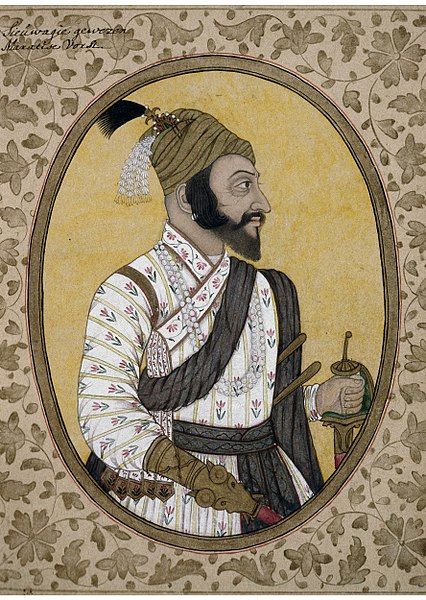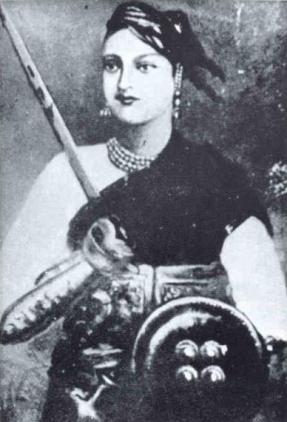Muhi-ud-Din Muhammad (3 November 1618 – 3 March 1707),[1] commonly known by the sobriquet Aurangzeb (Persian: "Ornament of the Throne")[3] or by his regnal title Alamgir (Persian: "Conqueror of the World"),[4] was the sixth Mughal emperor, who ruled over almost the entire Indian subcontinent for a period of 49 years.[5][6][7] Widely considered to be the last effective ruler of the Mughal Empire,[8] Aurangzeb compiled the Fatawa-e-Alamgiri, and was among the few monarchs to have fully established Sharia law and Islamic economics throughout the Indian subcontinent.[9][10][page needed] He was an accomplished military leader[11] whose rule has been the subject of praise, though he has also been described as the most controversial ruler in Indian history.[12]
He was a notable expansionist; during his reign, the Mughal Empire reached its greatest extent, ruling over nearly all of the Indian subcontinent.[13] During his lifetime, victories in the south expanded the Mughal Empire to 4 million square kilometres,[14] and he ruled over a population estimated to be over 158 million subjects,[13] Under his reign, India surpassed Qing China to become the world's largest economy and biggest manufacturing power, worth nearly a quarter of global GDP and more than the entirety of Western Europe, and its largest and wealthiest subdivision, the Bengal Subah,[15] signaled the proto-industrialization.[16][17][18][page needed]
Aurangzeb was noted for his religious piety; he memorized the entire Quran, studied hadiths and stringently observed the rituals of Islam.[19][20] Unlike his predecessors, including his father Shah Jahan, Aurangzeb considered the royal treasury to be held in trust for the citizens of his empire.[20][page needed][21][page needed] He did not enjoy a luxurious life and his personal expenses and constructions of small mosques were covered by his own earnings, which included the sewing of caps and trade of his written copies of the Quran.[22][23] He also patronized works of Islamic and Arabic calligraphy.[24]
Aurangzeb has been subject to criticism. Critics argue that his policies abandoned his predecessors' legacy of pluralism and religious tolerance, citing his introduction of the jizya tax and other policies based on Islamic ethics, demolition of Hindu temples, the executions of his elder brother Dara Shikoh, Maratha king Sambhaji[25][26] and the Sikh Guru Tegh Bahadur,[27][28][a] and the prohibition and supervision of behaviour and activities that are forbidden in Islam such as gambling, fornication, and consumption of alcohol and narcotics.[29][30] Some historians question the historicity of the claims of his critics, arguing that his destruction of temples has been exaggerated,[31][32] and noting that he also built temples,[33] paid for their maintenance, employed significantly more Hindus in his imperial bureaucracy than his predecessors did, and opposed bigotry against Hindus and Shia Muslims.
Early life
A painting from c. 1637 shows the brothers (left to right) Shah Shuja, Aurangzeb and Murad Baksh in their younger years.
Aurangzeb was born on 3 November 1618, in Dahod, Gujarat. He was the third son and sixth child of Shah Jahan and Mumtaz Mahal.[35] In June 1626, after an unsuccessful rebellion by his father, Aurangzeb and his brother Dara Shukoh were kept as hostages under their grandparents' (Nur Jahan and Jahangir) Lahore court. On 26 February 1628, Shah Jahan was officially declared the Mughal Emperor, and Aurangzeb returned to live with his parents at Agra Fort, where Aurangzeb received his formal education in Arabic and Persian. His daily allowance was fixed at Rs. 500, which he spent on religious education and the study of history.
On 28 May 1633, Aurangzeb escaped death when a powerful war elephant stampeded through the Mughal Imperial encampment. He rode against the elephant and struck its trunk with a lance,[36] and successfully defended himself from being crushed. Aurangzeb's valour was appreciated by his father who conferred him the title of Bahadur (Brave) and had him weighed in gold and presented gifts worth Rs. 200,000. This event was celebrated in Persian and Urdu verses, and Aurangzeb said:[37][clarification needed]
If the (elephant) fight had ended fatally for me, it would not have been a matter of shame. Death drops the curtain even on Emperors; it is no dishonor. The shame lay in what my brothers did!
Early military campaigns and administration
Bundela War
The Mughal Army under the command of Aurangzeb recaptures Orchha in October 1635.
Aurangzeb was nominally in charge of the force sent to Bundelkhand with the intent of subduing the rebellious ruler of Orchha, Jhujhar Singh, who had attacked another territory in defiance of Shah Jahan's policy and was refusing to atone for his actions. By arrangement, Aurangzeb stayed in the rear, away from the fighting, and took the advice of his generals as the Mughal Army gathered and commenced the Siege of Orchha in 1635. The campaign was successful and Singh was removed from power.[38]
Viceroy of the Deccan
A painting from Padshahnama depicts Prince Aurangzeb facing a maddened war elephant named Sudhakar.[39]
Aurangzeb was appointed viceroy of the Deccan in 1636.[40] After Shah Jahan's vassals had been devastated by the alarming expansion of Ahmednagar during the reign of the Nizam Shahi boy-prince Murtaza Shah III, the emperor dispatched Aurangzeb, who in 1636 brought the Nizam Shahi dynasty to an end.[41] In 1637, Aurangzeb married the Safavid princess Dilras Banu Begum, posthumously known as Rabia-ud-Daurani. She was his first wife and chief consort as well as his favourite.[42][43][44] He also had an infatuation with a slave girl, Hira Bai, whose death at a young age greatly affected him. In his old age, he was under the charms of his concubine, Udaipuri Bai. The latter had formerly been a companion to Dara Shukoh.[45] In the same year, 1637, Aurangzeb was placed in charge of annexing the small Rajput kingdom of Baglana, which he did with ease.[19]
In 1644, Aurangzeb's sister, Jahanara, was burned when the chemicals in her perfume were ignited by a nearby lamp while in Agra. This event precipitated a family crisis with political consequences. Aurangzeb suffered his father's displeasure by not returning to Agra immediately but rather three weeks later. Shah Jahan had been nursing Jahanara back to health in that time and thousands of vassals had arrived in Agra to pay their respects.[citation needed] Shah Jahan was outraged to see Aurangzeb enter the interior palace compound in military attire and immediately dismissed him from his position of viceroy of the Deccan; Aurangzeb was also no longer allowed to use red tents or to associate himself with the official military standard of the Mughal emperor.[citation needed] Other sources tell us that Aurangzeb was dismissed from his position because Aurangzeb left the life of luxury and became a Faqir.[46]
In 1645, he was barred from the court for seven months and mentioned his grief to fellow Mughal commanders. Thereafter, Shah Jahan appointed him governor of Gujarat where he served well and was rewarded for bringing stability.[citation needed]
In 1647, Shah Jahan moved Aurangzeb from Gujarat to be governor of Balkh, replacing a younger son, Murad Baksh, who had proved ineffective there. The area was under attack from Uzbek and Turkmen tribes. While the Mughal artillery and muskets were a formidable force, so too were the skirmishing skills of their opponents. The two sides were in stalemate and Aurangzeb discovered that his army could not live off the land, which was devastated by war. With the onset of winter, he and his father had to make a largely unsatisfactory deal with the Uzbeks, giving away territory in exchange for nominal recognition of Mughal sovereignty. The Mughal force suffered still further with attacks by Uzbeks and other tribesmen as it retreated through the snow to Kabul. By the end of this two-year campaign, into which Aurangzeb had been plunged at a late stage, a vast sum of money had been expended for little gain.[47]
Further inauspicious military involvements followed, as Aurangzeb was appointed governor of Multan and Sindh. His efforts in 1649 and 1652 to dislodge the Safavids at Kandahar, which they had recently retaken after a decade of Mughal control, both ended in failure as winter approached. The logistical problems of supplying an army at the extremity of the empire, combined with the poor quality of armaments and the intransigence of the opposition have been cited by John Richards as the reasons for failure, and a third attempt in 1653, led by Dara Shikoh, met with the same outcome.[48]
Aurangzeb became viceroy of the Deccan again after he was replaced by Dara Shukoh in the attempt to recapture Kandahar. Aurangzeb regretted this and harboured feelings that Shikoh had manipulated the situation to serve his own ends. Aurangbad's two jagirs (land grants) were moved there as a consequence of his return and, because the Deccan was a relatively impoverished area, this caused him to lose out financially. So poor was the area that grants were required from Malwa and Gujarat in order to maintain the administration and the situation caused ill-feeling between father and son. Shah Jahan insisted that things could be improved if Aurangzeb made efforts to develop cultivation.[49] Aurangzeb appointed Murshid Quli Khan[citation needed] to extend to the Deccan the zabt revenue system used in northern India. Murshid Quli Khan organised a survey of agricultural land and a tax assessment on what it produced. To increase revenue, Murshid Quli Khan granted loans for seed, livestock, and irrigation infrastructure. The Deccan returned to prosperity,
Aurangzeb proposed to resolve the situation by attacking the dynastic occupants of Golconda (the Qutb Shahis) and Bijapur (the Adil Shahis). As an adjunct to resolving the financial difficulties, the proposal would also extend Mughal influence by accruing more lands.[49] Aurangzeb advanced against the Sultan of Bijapur and besieged Bidar. The Kiladar (governor or captain) of the fortified city, Sidi Marjan, was mortally wounded when a gunpowder magazine exploded. After twenty-seven days of hard fighting, Bidar was captured by the Mughals and Aurangzeb continued his advance.[51] Again, he was to feel that Dara had exerted influence on his father: believing that he was on the verge of victory in both instances, Aurangzeb was frustrated that Shah Jahan chose then to settle for negotiations with the opposing forces rather than pushing for complete victory.






0 Comments